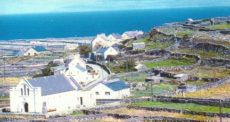“The Truth about the Aran Sweater”
Written by Yaichiro Nozawa, October 2001
(This text is an abridged version of a section of my book “Ireland: The Legend of the Aran Sweater”).
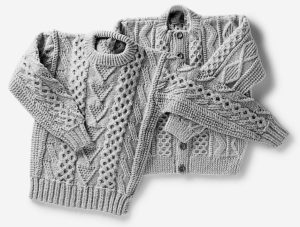
Have you ever heard of the ‘Aran Sweater’?
It is a white jumper with a raised rope-knitted pattern that became very popular in Japan in the early 1970s, and was originally knitted by women on the Aran Islands off the west coast of Ireland. The jumpers are still knitted on the islands today.
Legend of the Aran jumper
The jumper has traditionally been associated with the following stories.
The Aran jumper has been knitted in the Aran Islands since the 6th century, and its unique knitting pattern is a prayer of women for the safety of their husbands on fishing trips and for a good catch. The combination of these patterns differs from family to family, just like a family crest, and is handed down from mother to daughter.
It is said that in the unlikely event of a drowning victim from a fishing accident being washed ashore, their identity could be determined by the pattern of the sweater they were wearing.
 Men rowing out into the rough sea, and the love of women gently surrounding them. This story became well known to everyone as the Aran jumper spread around the world, and has even become a legend.
Men rowing out into the rough sea, and the love of women gently surrounding them. This story became well known to everyone as the Aran jumper spread around the world, and has even become a legend.
Meeting an old man.
I am a clothing shop owner in Shizuoka City and have been fascinated by the Aran Sweat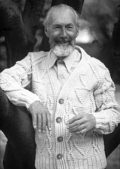 er ever since I met Padraig O’Shiochain, a former Irish lawyer who introduced the jumper to the world for 40 years, about ten years ago. I has been his agent in Japan in addition to his day job.
er ever since I met Padraig O’Shiochain, a former Irish lawyer who introduced the jumper to the world for 40 years, about ten years ago. I has been his agent in Japan in addition to his day job.
When he passed away six years ago at the age of 90, I decided that I had to preserve a record of these jumpers, and I have been researching them for a long time, which has now finally come together.
The origin of the Aran jumper
The birthplace of the Aran jumper The Aran Islands are known as one of Ireland’s most exotic islands, where indigenous Celtic customs remain strong, thanks to J.M. Sing’s essay ‘Aran Islands’ and R. Flaherty’s film ‘ Man of Aran’. It is a poor, rocky, small island with little grass and trees, and a harsh life where even the daily fishing is a life-threatening experience. How and when was the Aran jumper born on this island?
Fortunately, knitwear enthusiasts and fashion journalists in Britain, the USA and Ireland have already largely solved this mystery. The truth, as discovered by consulting these sources, is quite different from the legend.
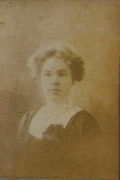 The legendary 6th century date of origin was in fact the beginning of the 20th century. It was based on the gansey jumpers of a Scottish family who frequented a fishing base on the Aran Islands, and the skill of a gifted knitter who had returned from America, combined with the island’s unique flamboyant aesthetic, resulted in the creation of a beautifully decorative jumper.
The legendary 6th century date of origin was in fact the beginning of the 20th century. It was based on the gansey jumpers of a Scottish family who frequented a fishing base on the Aran Islands, and the skill of a gifted knitter who had returned from America, combined with the island’s unique flamboyant aesthetic, resulted in the creation of a beautifully decorative jumper.
 The mother knitted an extravagant white jumper for her 12-year-old son on the occasion of the church’s Confirmation Ceremony (the equivalent of a ceremonial dress rehearsal in our country).
The mother knitted an extravagant white jumper for her 12-year-old son on the occasion of the church’s Confirmation Ceremony (the equivalent of a ceremonial dress rehearsal in our country).
Crossing to the UK
In 1935, a woman named Muriel Gahan, who was working for the advancement of women’s status, came to the island, found a white Aran jumper and placed it in her shop in the capital, Dublin. The following year, the shop was visited by a clothing critic named H.E. Kieve, who introduced it to Britain on his own reasoning.
‘In the  Aran Islands, jumpers are knitted which are not to be found anywhere else in the world. A white jumper with a splendidly decorative knitting pattern, which was introduced by the saintly man Enda, who came to these islands in the sixth century.”
Aran Islands, jumpers are knitted which are not to be found anywhere else in the world. A white jumper with a splendidly decorative knitting pattern, which was introduced by the saintly man Enda, who came to these islands in the sixth century.”
And. He then, perhaps, has an imitation of this jumper made in Scotland and sold in the UK. Perhaps this was also related to the special international circumstances of the Great War, when he was a Jew in exile in Britain. The legend thus began to circulate.
Post-war exports to the USA
Afte r Ireland’s long-awaited independence in 1949 after years of British rule, it adopted an aggressive export policy towards the USA. Aran jumpers were the most important export item, and our benefactor P. O’Siochain was responsible for this.
r Ireland’s long-awaited independence in 1949 after years of British rule, it adopted an aggressive export policy towards the USA. Aran jumpers were the most important export item, and our benefactor P. O’Siochain was responsible for this.
However, at the time, Aran jumpers were still knitted only for family use, so the wool was too sticky and smelly, and the jumpers came in different sizes, so they could not be sold as they were.
He stayed on the island for a long time, organised the knitters, standardised the level of workmanship, and set up a production system for a saleable product, creating a form of cottage industry.
Christian Dior was the first to take notice of these jumpers in 1956. The magazines Vogue and Harper’s Bazaar introduced this latest Parisian trend to the USA.
In the early 1960s, the Aran jumper became a huge hit in the USA. The president at the time was J.F. Kennedy. He was a descendant of Irish immigrants. It was a time when Irish Americans, who had struggled as immigrants, were finally making a name for themselves. There was no shortage of welcoming jumpers in their legendary homeland.
 In 1961, the Clancy Brothers, a quartet of Irish folk idols at the time, appeared on The Ed Sullivan Show wearing matching white Aran jumpers. It was only a 16-minute broadcast, but it was the start of a nationwide craze.
In 1961, the Clancy Brothers, a quartet of Irish folk idols at the time, appeared on The Ed Sullivan Show wearing matching white Aran jumpers. It was only a 16-minute broadcast, but it was the start of a nationwide craze.
At this time, one Aran knitter was recorded to have knitted 41 jumpers in a year. The average speed was an astonishing one sweater every nine days. That’s how much demand there was.
And to Japan,
Men’s Club magazine, No. 40, December 1964, frontispiece. Young men playing darts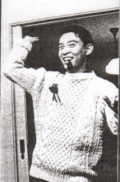 . A young man is wearing a beautiful aran jumper. He was Sokichi Shikiba, a car racer who had been racing in Europe at the time. He had acquired the jumper at Dior in Paris, but Shosuke Ishizu (son of the founder Kensuke) of Van Jacket, who was present during the photogravure, begged him to give it away. Van later named it the ‘Fisherman’s Sweater’ and made it hugely popular in Japan.
. A young man is wearing a beautiful aran jumper. He was Sokichi Shikiba, a car racer who had been racing in Europe at the time. He had acquired the jumper at Dior in Paris, but Shosuke Ishizu (son of the founder Kensuke) of Van Jacket, who was present during the photogravure, begged him to give it away. Van later named it the ‘Fisherman’s Sweater’ and made it hugely popular in Japan.
 Current situation on the island
Current situation on the island
The legend of the sixth century may be exaggerated, but the Aran jumper has been knitted for a hundred years and is still being knitted. From mother to daughter, without a blueprint, as the legend goes. No other jumper in the world has been knitted commercially and unchanged in its birthplace for a hundred years, except the Aran. This is the only proof that these jumpers have been fascinatingly beautiful jumpers.
However, the legend is dying out. Today, more than 100,000 tourists a year visit the Aran Islands in search of Celtic nostalgia and the beauty of the rugged landscape. Thanks to this, the islanders no longer have to knit jumpers to ‘make a living’.
Most women on the islands over the age of 70 can knit, but the number of women who knit on a regular basis is probably less than 40. Even the youngest women are around 40 years old, and the tradition has not been passed on to younger generations.
At present, it is estimated that about 300-400 pieces are woven annually. Two or three hundred are sent out of the island, most of which are sent back to Japan. The rest are sold directly to tourists on the islands. In a few years, the number of knitters will probably decrease dramatically, and the product will become a rarity that can only be obtained by going to the islands. It must be said that the light of the Aran jumper is already very thin.
 The island’s best knitter, Máirín Ní Dhomhnaill, who used to knit jumpers for the Pope, s
The island’s best knitter, Máirín Ní Dhomhnaill, who used to knit jumpers for the Pope, s topped knitting as a business when she turned sixty-five. Now she spends her days working at her knitting bar just for her family and for her own enjoyment. I remember her gentle, whispered narrative.
topped knitting as a business when she turned sixty-five. Now she spends her days working at her knitting bar just for her family and for her own enjoyment. I remember her gentle, whispered narrative.
‘I do not knit these jumpers. It is a gift from God, which He has allowed me to knit.”
One jumper has such a history and story. Acquiring an Aran jumper is more than just buying an expensive hand-knitted jumper; it means becoming a participant in this story.
(Yaichiro Nozawa / Jack Nozawaya, manager)
Postscript to 2022.
This text is a fairly short summary of the contents of my book for a contribution to the cultural section of a newspaper on the occasion of the publication of my book ‘Ireland / The Legend of the Aran Sweater’. Naturally, there are various more detailed stories in my book. Also, please read the article I contributed to ‘Woolly Balls’ in 2013, which is more detailed and easier to understand than the above summary, including images. Twenty years have passed since I wrote the book. The history part has not changed over the years, but as far as the last 20 years are concerned, the environment surrounding the Aran Sweater has changed a lot. However, when I wrote the book, I was pessimistic that I might only have 20 years left, but I am happy to say that I am still in the business of Aran Sweaters.

